Shaping Place: Identity as the Engine of Territorial Attractiveness

- What Is Territorial Identity?
- Why It Matters More Than Ever
- A Strategic Tool for Territorial Development
- Territorial Identity and Territorial Attractiveness
- The AI Opportunity
What Is Territorial Identity?
Territorial identity refers to the sense of belonging and uniqueness that a specific place holds. It is shaped by geography, history, culture, architecture, and the values shared by its inhabitants. It influences how people interact with their environment and how they project themselves into the future.
Territorial identity is not a nostalgic fixation on the past; it is a dynamic and evolving foundation that allows communities to face future challenges with confidence.
Why It Matters More Than Ever
From urban development to tourism strategies, too many projects ignore the DNA of the territory they seek to transform. The result? Generic spaces, disconnection between citizens and their environment, and a loss of civic pride.
As Michelle Obama once said, “The difference between a broken community and a thriving one is the presence of women who are valued.” In the same spirit, the difference between a fragmented territory and a vibrant one lies in how much we value its identity.
When projects are rooted in the identity of a place, they are more likely to be accepted, to be sustainable, and to spark a sense of ownership. This is true for a coastal town protecting its fishing heritage, a mountain village modernizing its trails, or a medina integrating technology into traditional crafts.
A Strategic Tool for Territorial Development
Embracing territorial identity means asking the right questions:
- What makes this place unique?
- How do its people see their future?
- What can we preserve, adapt, or reimagine?
Answering these questions can guide planners, architects, and policymakers to create more resilient, inclusive, and culturally grounded solutions.
Territorial Identity and Territorial Attractiveness
Territorial identity plays a central role in defining and enhancing territorial attractiveness. A territory that expresses its unique character, values, and culture not only strengthens the pride and cohesion of its population, but also becomes more appealing to visitors, investors, and new residents.
Places that embrace their identity — through architecture, local governance, inclusive public spaces, or cultural narratives — stand out in a world of sameness. Territorial attractiveness is not about copying what worked elsewhere; it’s about highlighting what makes a place irreplaceable.
The AI Opportunity
In the digital age, artificial intelligence offers new ways to capture and enhance territorial identity. From geospatial data analysis to sentiment mining in local narratives, AI can help map cultural assets, identify development patterns, and forecast impacts with precision.
AI-powered tools can assist decision-makers in creating tailored strategies for regional attractiveness by:
- Highlighting underused local assets;
- Anticipating urban dynamics and demographic shifts;
- Personalizing citizen engagement based on territorial profiles.
Far from replacing human judgment, AI complements it — providing clarity and data-driven insight that can enhance the authenticity and appeal of a place.
The future of development isn’t in abstract plans — it is in the soul of places, the voices of those who live there, and the intelligent systems that help us understand them better. As Winston Churchill once said, “We shape our buildings, and afterward our buildings shape us.” This truth extends to the territories we inhabit. The way we shape space ultimately shapes our collective destiny.
That’s why public decision-makers have a crucial responsibility: to recognize, preserve, and amplify the identity of each territory in their strategic choices. Territorial identity is not an accessory — it is the backbone of meaningful, sustainable development.
Salma Abalhssain, Territorial Planning Researcher at the National Institute of Development and Town Planning Morocco (INAU)



